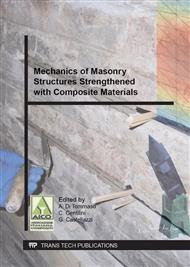p.214
p.222
p.230
p.238
p.246
p.254
p.266
p.275
p.283
Numerical Analysis of Masonry Enhanced by Fiber Reinforced Lime-Based Render
Abstract:
Out of plane load bearing capacity of a masonry structure enhanced by surface render made of high performance lime-based mortar is investigated by numerical simulations using the finite element method (FEM). The response of the wall is simulated firstly without render (as a reference) then with surface render consisting of conventional lime mortar with increased tensile strength (by addition of the metakaolin) without fibers and finally with the proposed lime-metakaolin mortar reinforced with PVA fibers. The thickness of the surface render is considered in two configurations (20 mm and 40 mm). Material parameters of masonry units (bricks), joints (mortar between bricks) and conventional plain render are chosen with regard to investigations of historic structures (reported in the literature), material characteristics of fiber reinforced render are evaluated based on experiments or numerical simulations of these experiments. Using these parameters and characteristics, the numerical simulations of masonry wall subjected to out of plane bending are performed. The results allow us to identify influence of the thickness and the material of render on load-bearing and deformation capacity, failure mode and amount and width of cracks. The results show that the conventional plain mortar improves load-bearing capacity and deformation capacity proportionately to the thickness of render, but the response remains brittle. Fiber reinforced mortar significantly increases the deformation capacity and load-bearing capacity and the amount of absorbed energy is significantly improved.
Info:
Periodical:
Pages:
246-253
Citation:
Online since:
September 2014
Authors:
Price:
Сopyright:
© 2015 Trans Tech Publications Ltd. All Rights Reserved
Share:
Citation:


